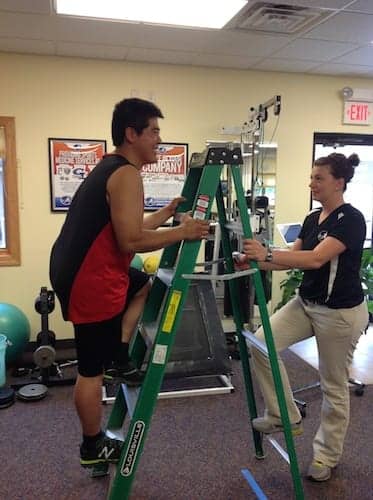From the initial patient visit to employer follow-up, creating a satisfactory experience can ensure successful outcomes and lasting relationships with all parties
By Larry Briand, MS, PT, ATC, and Emily Monson, PT
Workers’ compensation cases can be vital to a practice’s health, as in most states, they create a healthy balance and mitigate the financial risks we take with other payors. In order to create a thriving industrial rehabilitation program, it is essential to remember that you never get a second chance to make a first impression and the interactions held with the patient, employer, physician, and case manager at the time of evaluation can make or break you. This article will discuss how you can create an amazing “guest” experience beginning at the first visit, resulting in long-lasting relationships with referral sources and raving fans in patients and employers.
Initial Patient Visit
The moment a workers’ compensation patient is referred to your office, it is important that your office manager or clerical staff obtains the key details of the case. These include: name and contact information for the employer, the name of his/her direct supervisor or human resource director, the workers’ compensation claim status, any current restrictions set by the referring physician, an order for physical therapy (requirements vary by state), and any important medical reports. If a job description is available, this can be obtained from the known employer. Coordinating this information prior to the patient’s first visit will maximize the intake process and allow the provider to have a better understanding of the case.
The clerical staff is most often the first interaction a patient will have with any practice. It is fundamental that upon the patient’s arrival for the first visit, the customer experience is a positive and informative one. Injured workers come to you in their most intimate time—when they are feeling pain and may have experienced changes in their work abilities. Providing a helpful environment and exceptional customer service helps ease the patient’s mind and makes a great first impression. The office staff can help to maximize understanding of the claim status for the patient by explaining the details of the claim at the time of evaluation.
Intake Process: Job Demands Assessment
The intake process should include collecting information specific to the tasks and demands of an individual’s work requirements. Obtaining this data assists with goal development, establishes baseline data on the physical demands of the job, and encourages the treating therapist to think about all of the potential needs in a given plan of care. An intake form that includes the functional design of what a worker does in a given day can provide useful information about the demands of the job, tasks that are difficult for a worker, and how the worker’s injury occurred. This kind of document should gather information about the patient’s demographics, employer information, required job tasks, and the frequency and duration of each job task.
The Art of Functional Goal Writing
Once the intake process is complete, the clinician is the next in line to create a positive impression with the patient. As a rehabilitation professional, it is your responsibility to ensure patients receive quality care without interruption. Lack of clarity in the evaluation documentation can result in authorization denials, potentially causing the patient to have a lapse in care or terminate treatment and not reach a full recovery. Mastering the art of proper functional goal writing protects the patient, and leads to better outcomes.
Functional goal writing in the evaluation provides case managers, referral sources, and payors a clear picture of the plan of care, and portrays the need for the patient to receive skilled care. A well-written functional evaluation goal includes the following:
• The area of the body you are referring to;
• Type of impairment—strength, ROM, pain, etc;
• The impairment goal—what this will change to and to the degree or level;
• Functional activity to be performed specific to the workplace;
• Target performance for the activity—frequency, length of time;
• Rationale as to why this activity must be met specific to the job; and
• Target time frame or date when the patient is expected to meet the goal.
Well-written goals demonstrate the functional activates a patient must return to in order to properly perform his/her job. For example, a good goal would read: “Client’s knee strength and motor control will improve, allowing him to climb ladders or stairs on an occasional basis with step heights up to 3 feet to enter and exit equipment as a diesel mechanic. 16 weeks.”1
To complement the functional goal writing, the documentation should also include any complementary services that may be necessary throughout the plan of care to enhance the patient’s outcomes. Be comfortable discussing the potential need and benefit of future job site assessments, work hardening and conditioning programs, and the need for regular functional progress reporting. When your plan of care explains the potential needs early with the insurance adjustor, case manager, and physician, it will help to ensure that all requested services will be recognized and approved when appropriate.
Communication and Enhancing the Patient Experience
There are several opportunities that follow an initial evaluation that help your practice build on the customer service experience for all parties involved in this case. Various communication strategies are important and will be performed by the office staff as well as the clinician. A summary of the initial evaluation should be sent to the physician to not only ensure he/she is in agreement with the plan of care, but also to assist with any work modification updates. The case manager should be informed that the patient was seen, and to discuss any potential complementary services that might be needed throughout the plan of care. Educating the case manager about the necessity of these services is often appreciated. This is also an opportunity to provide additional information about what these programs include.
To further enhance the patient experience, it is a great idea to send a follow-up letter thanking him/her for coming to your practice. Contact information for the patient’s therapist should be included to encourage the patient to bring questions and concerns to the provider at any time. Again, you want to help reduce any anxiety the patient may have with his or her condition.
Too often, practices will ignore following up with the employer. Connecting and educating about this component is very helpful for employee recovery. Proactive communication with the employer can also lead to future networking and cash-based opportunities, such as injury prevention services, later on. Following the evaluation, the office staff can also create a letter to educate the employer that you are currently working with the employee and the steps you plan to take to return him/her back to work. Again, an outline of services may be useful to include along with the letter to educate the employer as to why they may be necessary and beneficial in the employee’s recovery.
A Comprehensive Approach to Patient Care
Taking the time to do the listed steps for the patient and all individuals involved in a workers’ compensation case at the initial visit will help to create long-lasting relationships and raving fans. The evaluation in a workers’ compensation case sets the stage for how a patient, referring physician, case manager, and employer perceives your practice. A practice’s front desk can assist in all communications processes from collecting all necessary information prior to the patient’s visit, correctly completing all intake information to set the provider up for success, and promptly following up with the correct individuals.
The therapist should set expectations of potential complementary services that would benefit the patient’s recovery during the plan of care at the time of evaluation, and master the art of functional goal writing to ensure the patient does not have a disruption in his/her treatment. By creating a positive first impression with all parties in the case management process, you can secure the well-being of your practice. PTP





